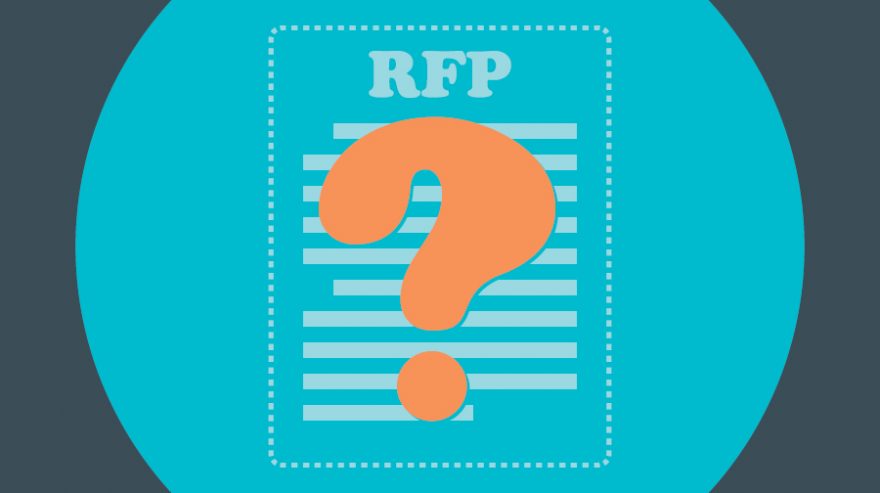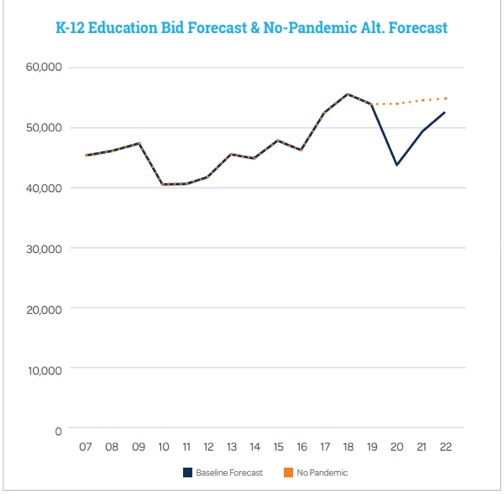COVID-19 Slows the Tide of K-12 RFPs, But Rebound Expected in 2021 and 2022

The number of published solicitations in K-12 declined sharply in 2020 — dropping to the lowest in almost a decade — but the education sector is poised to return to pre-pandemic levels for RFPs faster than many other government markets that buy products and services, according to GovWin from Deltek.
Last year’s dip in solicitations was due primarily to a tectonic shift in school district spending and purchasing priorities as a result of COVID-19 and the mass move to remote learning.
Districts typically rely on RFPs and bids as part of the procurement process, but in many cases last year did not want to wait through the long process involved with those traditional purchasing vehicles. School systems also relied on sole-source (non-competitive) procurements or turned to cooperatives last year to purchase goods and services quickly, according to GovWin from Deltek, which tracks published solicitations.
The company estimates that K-12 RFPs and bids fell off by 18.5 percent during 2020 compared to the same period a year earlier, according to its recent “State and Local Procurement Snapshot – Q4 2020” report.

The report, which analyzed RFPs and bids from all public school districts with an enrollment of more than 500 students, says that K-12 solicitation volume is expected to grow by 13 percent this year and then almost another 5 percent in 2022 as spending and purchasing conditions normalize further.
“Education overall is one of the markets that’s going to rebound most effectively through the next two years,” said Morgan Parkin, a research analyst for GovWin at Deltek.
That rebound, said Parkin, has already started, fueled in part by several rounds of federal emergency dollars.
She is forecasting that soft demand in a broad swath of K-12 spending categories should begin to reverse, and vendors could “start to notice those changes as early as now.” At the same time, solicitations for some “high priority purchases” have remained strong in recent months, according to the report.
Two big areas Parkin said she’s noticing an uptick for published solicitations is STEM curriculum and career and technical education programs.
She also expects to see an increase in school districts issuing bids for assessment programs. Moving forward, districts could be issuing solicitations for a broader mix of assessment tools “coming from all types of vendors, large and small,” to better understand achievement gaps caused by the pandemic,” according to the report.
“A major contract might get split up into smaller ones so more vendors can get in on it,” Parkin said, noting that districts might be less willing to sign with a big assessment provider for multiple years. “There’s going to be more work in assessments, but it will look a little different going in 2021 and 2022.”
Demand should also stay steady for digital textbooks, small-scale remote learning tools, and computer equipment — all tools needed in case of another move back to distance learning.
Rising Interest in PD, and Consulting
The report notes that vendors should “continue to watch for opportunities across all aspects of education, as this market involves a vast amount of services, supplies, systems, software, construction and maintenance. “ Districts not only have more money at their disposal now than at some points in 2020, as a result of a new federal stimulus, but more time and increased flexibility in how they use those funds.
“Spending has returned already at the start of 2021,” Parkin said.
Bids and RFPs issued by independent school districts rose from about 45,000 in 2014 up to 53,864 in 2019, for a compounded annual growth rate of 3.6 percent.
In 2020, the total was 43,903, which was the lowest since 2012, according to data from GovWin from Deltek.
GovWin from Deltek provides business customers with market intelligence and leads on federal, state, local, and education government contracting. A recent analysis by the organization of contracting in the K-12 and higher education markets can be found here.
Through 2020, schools showed a strong interest in procuring supplies and safety products. But as the year progressed, so did district needs, as more schools issued bids for COVID testing services and there was a stronger focus on consulting and professional development, according to GovWin from Deltek.
Parkin said she expects the trend from 2020 of districts using cooperative purchasing to continue, but that school systems will likely rely on sole-source procurements with less frequency since they have more money and are no longer facing do-or-die timelines for purchases.
Also, Parkin anticipates that a trend in districts making more contract opportunities available to minority- and women-owned businesses will continue.
And she has a message for vendors: Virtual sales pitches and demonstrations are still in demand, based on RFPs in 2021 that Parkin has analyzed, even as the pandemic subsides.
“Schools will be more willing to entertain the option of a virtual presentation,” she said. “I’ve seen more bids and RFPs that list it as an option, so that won’t be gone completely even as the world returns to normal in terms of spending.”
Image by Getty
See also:
